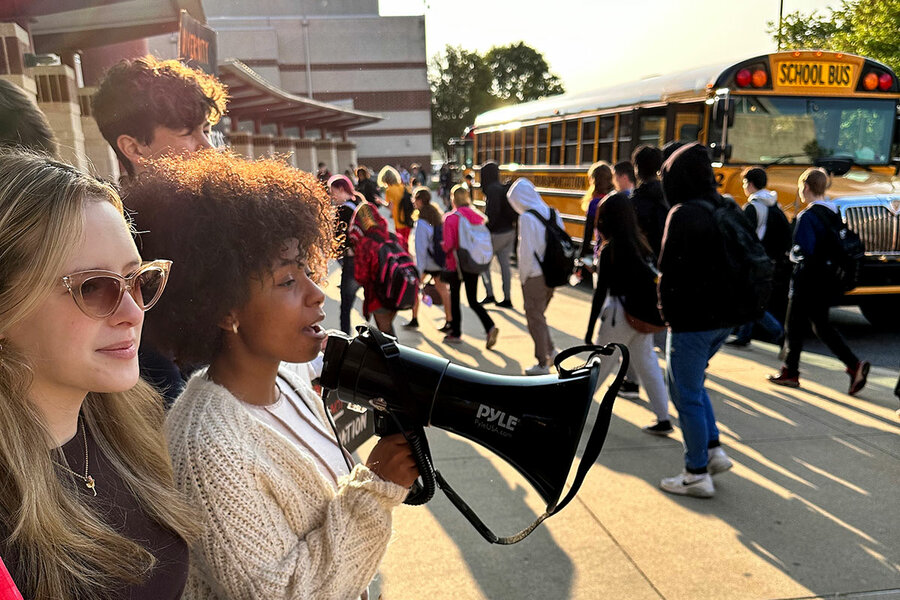‘We weren’t being heard’: Teens fight for say in school book choices
Loading...
As public debate around banning books in schools has increased, so has youth activism – drawing students to school board meetings and peaceful protests.
For the young people, it has been less about entering the culture war fray and more about magnifying student perspective.
Why We Wrote This
A story focused onBook challenges at U.S. schools are often dominated by adults. But teens are amicably inching their way into the discussion, with the goal of amplifying student perspective.
School book bans increased 28% during the first semester of the 2022-23 academic year compared with the prior six months, according to an analysis by PEN America. Many of the challenged titles are written by or about people of color or those within the LGBTQ+ community, or address race, racism, gender, or sexuality.
“These are the books that are in our schools and our libraries,” says Thomasina Brown, a senior at Nixa High School in Missouri and a member of Nixa Students Against Book Restrictions. “And we felt that we weren’t being heard.”
The school board there voted in June to remove three books and restrict two more by requiring parental permission. The board also decided to retain without restrictions “Maus” by Art Spiegelman, for example.
When board members explained why they voted a certain way, they cited some of the points made by students. Thomasina considers that progress.
“It took a while for that to actually happen,” she says, “but it felt like a step in the right direction.”
Deliliah Neff knows Nixa, the southwestern Missouri city where she is growing up, has some cultural limitations.
Located in Christian County, the city has roughly 24,000 residents, who are overwhelmingly white. So the 17-year-old has turned to literature to fill in those gaps. But a book she is currently reading – “All Boys Aren’t Blue,” a series of personal essays about race and LGBTQ+ issues by George M. Johnson – no longer lives on the shelves of her high school library. She received it as a Christmas gift.
“Hearing about these stories from authors of color, it’s really important for me, especially because when I go to college, I want to leave Nixa and venture out,” she says.
Why We Wrote This
A story focused onBook challenges at U.S. schools are often dominated by adults. But teens are amicably inching their way into the discussion, with the goal of amplifying student perspective.
The Nixa School Board voted to remove it last year. Since then, other books have been pulled or restricted, but not without pushback from the community’s teenage readers. Nixa Students Against Book Restrictions (SABR), a grassroots-style group, has rallied to keep its school library’s collection intact.
Fueled largely by parental demands and new state legislation, school book bans increased 28% during the first semester of the 2022-23 academic year compared with the prior six months, according to an analysis by PEN America, a group promoting free expression. Many of the challenged titles are written by or about people of color or those within the LGBTQ+ community, or address race, racism, gender, or sexuality.
In response, California lawmakers are considering a bill that would require a two-thirds majority vote from a school board or governing body before banning any instructional materials, textbooks, or curriculum.
The situation has inspired the latest iteration of youth activism, drawing students to school board meetings and peaceful protests, where they have advocated for their right to read a diverse set of books. They’re offering a counternarrative to discussions that, in many places, have featured hostile exchanges between adults against the backdrop of broader culture wars.
For them, it has been less about entering the fray and more about amplifying student perspective.
“These are the books that are in our schools and our libraries,” says Thomasina Brown, a senior at Nixa High School and member of Nixa SABR. “And we felt that we weren’t being heard.”
“A step in the right direction”
Upperclassmen started the group when book challenges made their way to Nixa during the 2021-22 school year, and now, students including Deliliah and Thomasina are carrying it forward. The group leaders regularly post on an Instagram account, letting fellow students know about upcoming board meetings, school board elections, and ways to address book bans. Among the recommendations: creating free little libraries, forming book clubs, and, of course, attending board meetings.
The movement is entirely student-led, in part because they’re hesitant to ask a teacher to serve as an adviser.
“We don’t want to put them in a position where they have to tell us no, even if they do agree with us,” Thomasina, who is 16, says.
Last year, Missouri legislators passed a law that includes an amendment putting school librarians and educators at risk of criminal prosecution if they provide “explicit sexual material” to a student. Nixa’s school board president, Joshua Roberts, says staff members flagged several books for evaluation because of the new state law. The other book challenges came from parents or community members.
Despite the students’ efforts, the school board in June voted to remove three books (“Blankets” by Craig Thompson; “Something Happened in Our Town” by Marianne Celano, Marietta Collins, and Ann Hazzard; and a graphic novel adaptation of “The Handmaid’s Tale” by Margaret Atwood) and restrict two more by requiring parental permission (“Lucky” by Alice Sebold and “Empire of Storms” by Sarah Maas).
A parent who spoke at the June meeting in support of removing certain books said they “contain obscene, sexually explicit content or provoke racial division,” according to a report from the Springfield News-Leader.
The board also decided to retain “Maus,” the Pulitzer Prize-winning graphic novel by Art Spiegelman, without restrictions. It did the same for “Unpregnant” by Jenni Hendriks and Ted Caplan after board members could not reach a majority vote in June and again in July.
When board members explained why they voted a certain way, they cited some of the points made by students. Thomasina considered that progress and a sign of more civil dialogue.
“It took a while for that to actually happen, but it felt like a step in the right direction,” she says. “We aren’t being completely seen or maybe understood, but at least we’re being heard to some extent.”
Preserving a path to empathy
The Panther Anti-Racist Union (PARU), a student group at Central York High School in Pennsylvania, persuaded its school board to go a step further: The board overturned a ban on several books in the school library and created a new policy, which allows parents to bar their own children from reading certain books without revoking them for the entire student body.
It was the second time the board has reversed course on such a decision. About two years earlier, also under pressure from students, the board undid a ban on resource materials about diversity and racial justice that staff members had gathered following the murder of George Floyd.
Mandy Wang, who is 17 and a PARU member, says students rallied outside the high school for weeks and also attended school board meetings. A concern for future generations fueled her motivation: She wants to ensure that her 6-year-old brother can continue reading books by diverse authors and learn about other communities and cultures as a result.
“With reading,” she says, “you become better at showing empathy and being able to empathize.”
Fellow PARU member, 15-year-old Brezlyn Koller, considers the policy change a fair compromise because it doesn’t take away other students’ rights to read a book. One of her favorite novels, “Push” by Sapphire, tells the story of a 16-year-old girl who has been abused and sexually assaulted. Brezlyn understands the subject matter may not be easy for others to digest.
“It’s a hard story to read, and it’s not for everyone,” she says. “But that doesn’t mean you can just take it out of a library.”
Ben Hodge and Patricia A. Jackson, who teach at Central York High School and serve as faculty advisers for PARU, credit their students with setting and controlling the narrative, dispelling misinformation along the way. Their advice to students: Keep at it.
“I’m always saying to the kids that it’s good to be vigilant in the turbulent times,” Ms. Jackson says. “But you have to be equally as vigilant in the quiet times.”
Throughout the history of the United States, youth activism has injected energy, exuberance, and optimism into social movements, which have helped sustain and keep them going, says Matthew Diemer, a professor of education and psychology at the University of Michigan. He sees opportunities for students to band together and form coalitions around their shared interests.
“I think it’s important to be active at the local level, but perhaps that can coalesce into something more regional or national,” he says.
Students at every board meeting
Back in Nixa, the school board wants students to be a permanent fixture at every board meeting going forward, says Mr. Roberts, the elected body’s president. This school year, a student representative from the high school – chosen without input from the board – will have dedicated speaking time at each meeting. Students can also continue to speak during the public comment periods.
Mr. Roberts says the students, unlike some adults who engaged in name-calling and other unruly behavior, brought a calming, mature presence to the discussions.
“There was zero hostility that came out of the students,” he says. “They were perfect. They always have been.”
Deliliah expects additional book challenges this school year, so she’s gearing up for more activism. Until then, she is focused on finishing “All Boys Aren’t Blue.”
“I think it’s a really good book,” she says, “and there are a lot of life lessons in there.”











